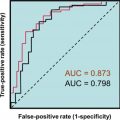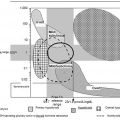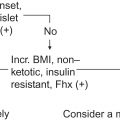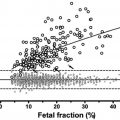Anterior pituitary
The anterior pituitary secretes the peptide hormones growth hormone (GH), prolactin (PRL), and adrenocorticotropin (ACTH) and the glycoprotein hormones thyroid-stimulating hormone (TSH), luteinizing hormone (LH), and follicle-stimulating hormone (FSH). The glycoproteins TSH, LH, and FSH are each dimers composed of a common α-subunit and a unique β-subunit. The hypophysiotropic regulation of the anterior pituitary is shown in Table 2.1 . Hypophysiotropic hormones from the hypothalamus reach the anterior pituitary via a portal venous system and either stimulate or inhibit the release of pituitary hormones. The hypothalamus serves as a relay station that receives chemical messages from higher brain centers and feedback information from target glands upon which the pituitary hormones act. The hypothalamus then integrates these messages before exerting its effect on the pituitary. These axes are described as closed-loop or negative feedback systems because hormones of target glands modulate hypothalamic and pituitary hormone release.
| Hypothalamus | Effect | Pituitary cell type (hormone) | Target gland product or effect |
|---|---|---|---|
| CRH | + | Corticotroph (ACTH) | Cortisol |
| GnRH a | + | Gonadotroph (LH and FSH) | Testosterone, estradiol |
| GHRH | + | Somatotroph (GH) | IGF-1 |
| TRH | + | Thyrotroph (TSH) and lactotroph (PRL) | T 4 and T 3 |
| SRIF(somatostatin) | − | Somatotroph (GH) and thyrotroph (TSH) | IGF-1 |
| Dopamine | − | Lactotroph (PRL) | Lactation |
a Previously referred to as luteinising hormone releasing hormone (LHRH).
Hypothalamic regulators of anterior pituitary hormones
Thyrotropin-releasing hormone (TRH) is a tripeptide that primarily stimulates the release of TSH. TRH also stimulates PRL secretion; elevated TRH due to primary hypothyroidism is a well-known cause of hyperprolactinemia. Gonadotropin-releasing hormone (GnRH) is a decapeptide that stimulates the release of both gonadotropins LH and FSH. GnRH is secreted episodically, resulting in pulsatile secretion of gonadotropins. Variability in the frequency of GnRH pulses determines the relative amounts of LH and FSH released. GnRH pulsatility maintains basal gonadotropin secretion, generates the phasic release of gonadotropins for ovulation, and determines the onset of puberty.
Somatostatin [somatotropin-release inhibiting factor (SRIF)] is a 14-amino acid peptide that inhibits GH and TSH secretion. In addition to its inhibitory role in the pituitary, SRIF plays an inhibitory role in the release of numerous other hormones throughout the body and is also known to have antitumor effects . GH-releasing hormone (GHRH) is a 44-amino acid peptide that specifically triggers release of GH. Ghrelin also stimulates GH release.
Corticotropin-releasing hormone (CRH) is a 41-amino acid peptide that stimulates the secretion of ACTH. ACTH is derived from a precursor molecule, pro-opiomelanocortin (POMC), made in the pituitary gland. Unlike the relatively transient response seen with other hypophysiotropic hormones, ACTH and cortisol levels remain elevated for several hours following CRH release. Dopamine is an important physiological inhibitor of PRL secretion. In the absence of dopamine, lactotrophs spontaneously secrete PRL .
Anterior pituitary hormone physiology and biochemistry
Histological staining techniques classify the cells of the pituitary as acidophils, basophils, or chromophobes. Somatotrophs and lactotrophs are acidophils that secrete GH and PRL, respectively, whereas mammosomatotrophs secrete both GH and PRL. Thyrotrophs, corticotrophs, and gonadotrophs are basophils that secrete TSH, ACTH, and the gonadotropins LH and FSH, respectively. The remaining chromophobe cells do not stain immunocytochemically. Newer immune-cytochemical staining techniques and electron microscopy now allow the cells of the anterior pituitary to be histologically classified according to their specific secretory products.
The main function of GH (a 191-amino acid polypeptide) is to stimulate linear growth during childhood. This effect is mediated by the somatomedins or insulin-like growth factors (IGFs), a group of small peptides produced by the liver and local tissues in response to GH. GH also directly stimulates lipolysis and has an antagonistic effect on insulin action. Its secretion is stimulated by sleep, exercise, stress, hypoglycemia, dopamine, certain amino acids, GHRH, β-blockers, and glucagon and inhibited by somatostatin and IGF-1. GH is secreted in an episodic and pulsatile manner, with the highest amplitude pulses occurring with sleep overnight. IGF-1 levels generally reflect the integrated secretory activity of GH given their much longer half-life .
PRL is a 198-amino acid polypeptide under tonic inhibition by dopamine. The primary effect of PRL is the initiation and maintenance of lactation in the postpartum period. Prolactin also plays a role in suppressing fertility . PRL is secreted in a pulsatile, episodic manner, with highest levels of secretion during sleep . Its secretion is increased by nipple stimulation, stress, exercise, sleep, TRH, and dopamine antagonists . Estrogen also enhances PRL secretion. Women taking oral contraceptives can have mild PRL elevations, and pregnant women have PRL levels up to 10 times the reference range .
TSH, a glycoprotein hormone is trophic to the thyroid gland and stimulates the synthesis and secretion of the thyroid hormones, thyroxine (T 4 ) and triiodothyronine (T 3 ). TSH secretion is finely regulated by the levels of thyroid hormones in the blood and by TRH.
ACTH is a 39-amino acid peptide, of which the first 24 amino acids are necessary for biological activity. Although ACTH mainly stimulates the synthesis and secretion of glucocorticoids, it also has an effect on the adrenal androgens. ACTH is secreted in a pulsatile manner with a diurnal rhythm (highest secretion in the early morning hours). Many types of stressors, including hypoglycemia, stimulate ACTH release, and ACTH secretion is inhibited by cortisol. Due to the melanocyte-stimulating action of POMC precursor molecule, excessive ACTH secretion can result in increased pigmentation. This has important implications when ACTH levels are excessively elevated for example in Addison’s disease.
The gonadotropins (LH and FSH), like TSH, are glycoprotein hormones for which the β-subunit confers the biological and immunodiagnostic specificity. In men, LH acts on Leydig cells to increase the synthesis and secretion of testosterone, whereas FSH (in concert with testosterone) acts on Sertoli cells to stimulate spermatogenesis. In women, LH stimulates estradiol and progesterone production by the ovary. A surge of LH in the mid-menstrual cycle is responsible for ovulation, and continued LH secretion subsequently maintains the corpus luteum and progesterone production. FSH regulates development of the ovarian follicle, and the secretion of estradiol from the follicle is dependent on variable ratios of LH and FSH. Both FSH and LH are under dual control of the hypothalamus and gonads.
This sentence should not be alone, please move up to join the paragraph above Sertoli cells within the testes and granulosa cells of the ovary produce inhibin-B that suppresses FSH secretion.
Features of hypopituitarism
Hypopituitarism is defined as a deficiency of one or many pituitary hormones. Isolated hormone deficiency (monohypopituitarism) is usually due to a hypothalamic disorder, whereas multiple hormone deficiencies (panhypopituitarism) can result from disorders of the pituitary gland or hypothalamus. Frequently, a stepwise loss of pituitary function occurs as a result of pituitary insult; GH or gonadotropin deficiency may precede the onset of thyrotroph and corticotroph injury. Clinical manifestations of hypopituitarism are not evident until at least 75% of the pituitary gland is destroyed. Causes of hypopituitarism are shown in Table 2.2 . The most common cause is pituitary neoplasm. In the postpartum period, spontaneous hemorrhage of a hypervascular and enlarged pituitary gland leads to infarction of the pituitary and acute hypopituitarism. This is referred to as Sheehan syndrome and classically presents with secondary amenorrhea and failure of lactation. Sheehan syndrome is an important cause of hypopituitarism, especially in developing countries. Anorexia nervosa, a psychological disorder characterized by self-imposed starvation and a preoccupation with body size, can resemble hypopituitarism with weight loss, amenorrhea, and decreased gonadotropins; however, cortisol and GH levels are usually increased.
| Tumors | Pituitary adenomas, craniopharyngiomas, metastatic carcinomas, meningiomas, gliomas, chordomas, pituitary hamartoma |
| Vascular disease | Sheehan syndrome, vascular malformations, sickle cell disease, pituitary apoplexy |
| Infiltrative disease | Sarcoidosis, tuberculosis, syphilis, hemochromatosis, histiocytosis-X, lymphocytic hypophysitis, histoplasmosis, amyloidosis |
| Trauma | Head injury, surgical |
| Iatrogenic | Irradiation, hormonal therapy |
| Miscellaneous | Congenital absence of the pituitary, isolated hormone deficiencies |
In adults, the manifestations of GH deficiency are usually subtle and nonspecific and include increased fat mass, decreased muscle mass, low energy, osteopenia, hypercholesterolemia, altered cardiac function, and poor quality of life . Hypoglycemia from GH deficiency in adults is rare, whereas in children, lack of GH commonly causes hypoglycemia. In children, height below 2 SD of the gender-specific population mean is the most obvious manifestation of GH deficiency.
The major consequence of PRL deficiency is failure of lactation. This is usually seen in Sheehan syndrome (postpartum pituitary necrosis with infarction), in which PRL deficiency is invariably accompanied by other hormone deficiencies. In men or nonlactating women, PRL insufficiency does not appear to be associated with any identifiable clinical manifestation.
Secondary hypothyroidism resulting from TSH deficiency produces a picture similar to that of primary hypothyroidism with weakness, lethargy, hypothermia, bradycardia, constipation, and delayed relaxation of deep tendon reflexes, although without a goiter. In children, TSH deficiency causes growth retardation . ACTH deficiency leads to adrenocortical insufficiency with decreased production of cortisol and adrenal androgens. The major clinical features of ACTH deficiency are fatigue, anorexia, nausea, and vomiting. Presenting features can be indolent and chronic or acute and life threatening, especially in the setting of acute stressors. Hypoglycemia and life-threatening hypotension may occur. Unlike patients with primary hypoadrenalism, patients with ACTH deficiency do not have hyperpigmentation. Furthermore, the renin-angiotensin-aldosterone axis is intact with ACTH deficiency such that hyperkalemia is usually not present. Hyponatremia, however, may be present due to impaired free water excretion .
Deficiency of gonadotropins in children results in delayed or partial puberty. If GH secretion is intact, patients have a eunuchoid habitus [tall with arm span>height and lower segment (pubis to ground)>upper segment (pubis to crown)] because fusion of the epiphyses is dependent on sex steroid production. Isolated GnRH deficiency can be associated with midline defects, nerve deafness, color blindness, and anosmia (Kallmann syndrome). When GnRH deficiency occurs after puberty, clinical features in males include loss of libido, impotence, loss of secondary sex characteristics (facial and body hair), and infertility (oligo- or azoospermia). Women may present with dyspareunia from vaginal mucosal atrophy or oligomenorrhea, infertility, or breast atrophy .
Investigation of hypopituitarism
Routine investigation of patients suspected of having hypopituitarism includes assessment of the visual fields and imaging studies of the pituitary fossa with magnetic resonance imaging (MRI). Initial biochemical screening to assess pituitary function includes measurement of TSH and free T 4 , PRL, IGF-1, LH, FSH, testosterone in males, and morning cortisol. Laboratory investigations should also be guided by clinical features suggestive of excess or deficiency of a particular hormone. The pulsatility and variability of GH and ACTH release limit the utility of random measurements. Ideally, a pooled sample should be obtained (three samples attained at 20-min intervals over 1 h) for an accurate assessment of LH, FSH, PRL, and testosterone. If this is not possible, an early morning 8–9 a.m. sample should be utilized for LH, FSH, PRL, TSH, FT4, and testosterone.
The most useful test to diagnose TSH deficiency is serum free T 4 because TSH levels can be low, normal, or high since immunoassays measure immune-reactive and not biologically active hormone.
The diagnosis of secondary hypothyroidism can be difficult in the face of major illness because the sick euthyroid syndrome can have similar biochemical features. In sick euthyroid syndrome TSH levels are often elevated above the upper reference interval (<10 mU/mL) but may be suppressed. This pattern is often dependent on stage of illness (acute vs resolving).
The best assessment of gonadotropin deficiency in premenopausal women is the menstrual history because menses usually cease with inadequate LH and FSH production. A useful index of ovulation is measurement of serum progesterone in the luteal phase because a value ≥5 ng/mL is supportive of ovulation. Men with gonadotropin deficiency have decreased levels of testosterone (total and bioavailable) with low or normal concentrations of FSH and LH. A semen analysis may also be useful especially if fertility is desired. Although TRH and GnRH have previously been used to test for TSH and gonadotropin deficiency, they are no longer commercially available and are used only at highly specialized research institutions.
A basal morning cortisol <3 μg/dL suggests hypoadrenalism . Morning cortisol concentrations above 15 μg/dL make hypoadrenalism unlikely. The most useful laboratory test to confirm a diagnosis of adrenal insufficiency is the ACTH stimulation test. Cosyntropin (ACTH 1–24) is injected intravenously at a dose of 250 μg, and cortisol concentrations are obtained at baseline and 30–60 min following the injection. In normal subjects, the peak cortisol is >20 μg/dL, and the increment over basal is >7 μg/dL. Low-dose ACTH testing (1 μg) has been suggested as a more sensitive test of impaired pituitary reserve . Whilst the use of the high-dose ACTH test is still very common, there is increased use of the low-dose test particularly in the pediatric population A subnormal response to ACTH is consistent with adrenocortical insufficiency but does not distinguish between primary and secondary causes because adrenocortical atrophy may be present with the latter. A plasma ACTH concentration and/or the clinical presentation of the patient will help delineate whether it is primary or secondary. However, a normal response to cosyntropin does not rule out impaired ACTH reserve (partial secondary insufficiency) due to hypothalamic or pituitary disease. In order to rule out secondary hypoadrenalism, other stimulation tests are required, such as the metyrapone test or the insulin-induced hypoglycemia challenge. The simplest metyrapone test entails giving metyrapone (30 mg/kg) at night and measuring plasma cortisol and 11-deoxycortisol the next morning. Metyrapone inhibits 11β-hydroxylase, which is the last step in cortisol synthesis by the adrenal glands. Cortisol production is therefore inhibited, resulting in elevated ACTH and 11-deoxycortisol production. Following metyrapone, the morning cortisol should be below 5 μg/dL, and the 11-deoxycortisol levels should exceed 7 μg/dL in normal subjects. A normal response to metyrapone denotes adequate function of the hypothalamic-pituitary-adrenal axis.
Insulin-induced hypoglycemia can also be a useful test to rule out central adrenal insufficiency. Insulin is given intravenously (0.1–0.15 unit/kg) until glucose falls to <40 mg/dL. Samples for glucose and cortisol are collected every 15 min until hypoglycemia is achieved and for 90 min afterward. A peak cortisol <20 μg/dL is suggestive of adrenocortical deficiency. Conveniently, this test can simultaneously be used to test for GH deficiency. It should not be performed in elderly patients or in patients with seizure disorders or clinical atherosclerotic cardiovascular disease due to the risk of inducing hypoglycemic seizure or a cardiovascular event.
Because GH is secreted in a pulsatile fashion, random GH measurements are useless in the diagnosis of GH deficiency. GHRH, arginine, insulin-induced hypoglycemia, clonidine, levodopa, glucagon, propranolol, sleep, fasting, and exercise have all been used as stimulatory tests for GH. Traditionally, insulin-induced hypoglycemia has been the gold standard; however, safety concerns have led investigators to compare the insulin tolerance test (ITT) with other stimuli. For the ITT, samples are obtained at 30-min intervals following adequate hypoglycemia (≤40 mg/dL); GH levels should exceed 5–10 ng/mL in normal patients. Combined GHRH and arginine testing has been shown to have equivalent sensitivity and specificity to ITT in both isolated GH deficiency and panhypopituitarism (with a GH cut-off of 5.1 μg/L for the ITT and 4.1 μg/L for the GHRH-arginine test) . Importantly, the ITT has the benefit of testing the entire hypothalamic-pituitary axis, whereas GHRH testing is likely to be normal in patients with hypothalamic causes of GH deficiency. Levels of IGF-1 and its binding protein, IGFBP-3, are dependent on GH secretion and are low with GH deficiency but may overlap into the normal reference range. Low concentrations of serum IGF-1 are confirmatory evidence of GH deficiency provided the patient is not malnourished, is hypothyroid, has hepatic insufficiency or poorly controlled type 1 diabetes mellitus, is taking high-dose oral estrogen, is chronically ill, or is elderly because all of these conditions are known to decrease IGF-1 levels . In patients with multiple preexisting pituitary hormone deficiencies or well-established hypothalamic or pituitary dysfunction, low IGF-1 levels alone may suffice in making the diagnosis of GH deficiency, and dynamic testing is not likely to provide further benefit . It is important to interpret IGF-1 concentrations with reference ranges for age and sex.
When provocative testing is used, a peak GH value of <5 μg/L is confirmatory of deficiency . Some experts advocate for at least two provocative testing modalities in order to confirm the diagnosis . The simplest test is to have the child exercise for 10 min and obtain a GH value at baseline and 10 and 20 min later . l -Arginine can be given (0.5 g/kg intravenously over 30 min; maximum dose, 30 g) with GH value obtained at 15-min intervals for 1 h . During the l -dopa test, GH values are obtained at 30-min intervals for 90 min after oral ingestion of l -dopa (125 mg for up to 15 kg of body weight, 250 mg for 15–30 kg, and 500 mg for >30 kg) . The GH response to oral clonidine can also be used (0.1–0.15 mg/m 2 ). However, clonidine can cause postural hypotension and must be used with caution. Glucagon can be given intramuscularly (0.03 mg/kg; maximum, 1 mg) with GH measurement every 30 min for 3 h; however, nausea and vomiting are common side effects. Lastly, GHRH can be given (1 μg/kg) with serial GH measurements obtained over 120 min ; however, a normal response to GHRH will not rule out a hypothalamic cause of GH deficiency.
During the pubertal growth spurt, rising levels of estrogen (from ovarian production in girls and from conversion of testosterone to estradiol in boys) cause increases in GH pulse amplitude secretion. For this reason, provocative testing for GH deficiency in prepubertal children may be falsely negative in the absence of endogenous estrogen. “Priming” patients for GH testing implies the administration of estrogen or testosterone prior to testing in order to decrease the likelihood of a falsely abnormal (deficient) GH response. Priming should be considered before GH testing procedures in prepubescent children, although a consensus on this practice is lacking . Although one can use estrogen priming in boys and androgen priming in girls, it is most reasonable to use androgens in boys and estrogens in girls. Androgens are most commonly administered as 50 mg of testosterone enanthate intramuscularly 2–3 weeks before the GH test. Ethinyl estradiol, Premarin, and diethylstilbestrol (DES) have been used as estrogen preparations in girls. Patients <22.7 kg (<50 pounds) receive 20 mg of ethinyl estradiol per dose 18, 12, and 1 h prior to GH testing. Patients >22.7 kg (>50 pounds) receive 50 mg per dose on the same schedule. Alternatively, 100 mg/day ethinyl estradiol for 3 days prior to testing can be used. In patients <13.6 kg (<30 pounds), 2.5 mg of Premarin is used twice daily for 3 days. In patients ≥13.6 (≥30 pounds), 5 mg of Premarin are used twice daily for 3 days. For DES, 5 mg/day for 3 days is used prior to GH testing. Alternative protocols for priming that do not involve sex steroids include the use of propranolol in a dose of 0.5–0.75 mg/kg (maximum 40 mg) or, for children <20 kg, 20 mg 2 h pretest and for children >20 kg, 40 mg 2 h pretest.
Secretory pituitary tumors
Pituitary tumors are the most common cause of hypopituitarism, but they may also be secretory tumors that cause unique clinical syndromes of hormone excess. Pituitary adenomas constitute about 10%–15% of all intra-cranial neoplasms. Pituitary tumors may manifest themselves as local space-occupying effects (with bitemporal visual field defects), hypopituitarism, hypersecretion of hormones, or as an incidental radiological finding.
Investigations (other than assessment of pituitary function) in patients with pituitary tumors include charting of visual fields and imaging studies of the pituitary fossa with computed tomography or MRI. Tumors with a diameter of <10 mm are referred to as microadenomas, whereas macroadenomas are >10 mm in maximal diameter. Less than 1% of all pituitary tumors are associated with multiple endocrine neoplasia type 1 (MEN1). The presence of other features of MEN1 or a suggestive family history should raise suspicion for MEN1 in patients with primary pituitary tumors. The initial tests should be directed at assaying the hormone whose excess is suspected. Additionally, the possibility of deficiencies of other pituitary hormones should also be considered and relevant testing performed as detailed previously . Patterns of excessive secretion of hormones are not uniform and may cycle between normal and excessive secretion due to the pulsatile and episodic secretion.
Prolactinomas
The causes of hyperprolactinemia are numerous ( Table 2.3 ) and include interruption of dopaminergic inhibition of lactotrophs (pituitary stalk compression or stalk injury and dopamine antagonists) and autonomous production by lactotrophs (prolactinomas or cosecreting tumors). Primary hypothyroidism can cause hyperprolactinemia due to elevated TRH. Prolactinomas are the most common secretory tumors of the pituitary and occur eight times more frequently in women than in men. Forty percent of all pituitary tumors are PRL secreting . Cosecretion of GH and prolactin is relatively common, occurring in 25% of secretory pituitary adenomas . Tumor size varies greatly from microadenomas to large invasive macroadenomas with extrasellar extension. Generally, PRL concentrations parallel prolactinoma size . Large nonfunctional pituitary tumors may cause mild elevations in PRL from stalk compression, leading to interruption of dopaminergic inhibition of PRL secretion. However, a mild elevation in PRL in the setting of a pituitary macroadenoma should prompt a dilutional assay for PRL because of the potential for a hook effect artifact when PRL concentrations are excessively high . Hyperprolactinemia causes inhibition of GnRH, LH, FSH, and gonadal steroidogenesis. Hence, female patients may present with amenorrhea and infertility in addition to galactorrhea and the local effects of tumor expansion. Males with prolactinomas may present with impotence, loss of libido, infertility, or gynecomastia from low testosterone concentrations in addition to galactorrhea and the effects of tumor expansion. Rarely, serum PRL may be elevated because of macroprolactinemia in the absence of a pituitary tumor. In this condition, the increase in serum PRL is due to large complexes of PRL and immunoglobulins. This “big PRL” has reduced biological activity, and the clinical consequences, if any, are unclear. The vast majority of patients with macroprolactinemia are asymptomatic; however, some may have a few nonspecific symptoms that may also occur in hyperprolactinemia, thus confounding the clinical differentiation of those with true monomeric increase from those with macroprolactin . In suspected macroprolactinemia, laboratory procedures for confirming macroprolactin are recommended . This may be done by one of the following methods: polyethylene glycol (PEG) precipitation, gel filtration chromatography, ultrafiltration, and immunoadsorption . Basal levels of prolactin are useful with values of >100 μg/L generally associated with the presence of a prolactinoma usually a microadenoma, and >200 μg/L due to a macroadenoma. Prolactin levels generally parallel the tumor size. In patients with microadenomas, other pituitary functions are usually normal; however, patients with macroadenomas should be assessed for hypopituitarism as outlined in previous sections. The most reliable tests for the diagnosis of a prolactinoma are several random measurements of PRL concentrations (preferably with pooled samples). Because the causes of hyperprolactinemia are numerous (pregnancy, drugs, hypothyroidism, chronic renal failure, etc.), a careful history, clinical examination, and routine laboratory tests are essential in evaluation of elevated PRL concentrations. PRL concentrations between the upper limits of normal and 100 ng/mL may be indicative of stalk compression, drugs, prolactinoma, or other causes, whereas PRL concentrations >100 ng/mL are usually caused by a prolactinoma. Concentrations >200 ng/mL are virtually diagnostic of prolactinoma . Provocative tests such as TRH, l -dopa, and insulin-induced hypoglycemia have not proven useful in the diagnosis of prolactinomas and are not indicated .








